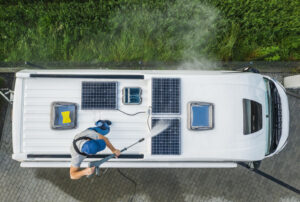
After your vacation ends and it’s time to get back to work, you will have to park your RV for an extended period. Storing your RV at a facility helps free up space on your property and allows your vehicle to stay safe and secure until the next time you plan to travel. However, you still need to prepare your RV for hibernation! An RV that is well-prepared for storage will have less risk of developing the mechanical and cosmetic problems that can sometimes come with long-term storage.
Here are a few things you must do to prepare your RV for long-term storage properly!
Prepare the Fridge and Freezer
The fridge and freezer can grow mold when not properly cleaned and emptied. The spores can then spread to other areas of the RV, ruining what was once a beautiful and functional vehicle.
Defrost the freezer and remove all the food from the freezer and fridge, including condiments. Wipe them out with a bleach and water mixture to kill any lingering bacteria. Leave the doors open until the water has completely dried. Check the gasket seals on both the fridge and the freezer and wipe them out, as these can sometimes become dirty over months of frequent use.
Prevent Mice and Pests
Since RV storage is usually open to the outdoors, you’ll want to ensure that you do everything possible to prevent mice or other pests from getting into your vehicle and making a home there.
Before storing your RV, make sure you:
- Pull out all drawers and wipe them out. Crumbs can fall into the space behind drawers, so pulling out the drawers and wiping behind them helps to get an even deeper clean.
- Wash down storage cupboards with a mild solution of dish detergent and water.
- Clear out all edible food. Never leave any food stored in your RV, even if it is sealed. The smell can draw in animals.
- Remove papers like maps, books, and old magazines that mice can use to build nests.
- Clear all bedding and vacuum mattresses, and couches to remove odors and stray crumbs.
- Repair any broken seals around doors and windows to prevent rodents from entering.
You should also check the RV’s underside to seal any cracks or holes leading up into the main living area. If your RV is a motorhome, ensure the engine area (which is exposed to the outside) is completely sealed off from the vehicle’s interior. Clean out the AC filter and cover any roof vents.
Protect the Exterior
The exterior of your motorhome is tougher than your interior, but if it sits for a long time, it will show signs of weather wear. The best thing to do for your motorhome is to wash it thoroughly from the top down and then give it a wax to help protect the finish.
When washing, be thorough. It’s a big job, but clearing dirt and debris from the small cracks and crevices will help to prepare for the wax coat and leave no area of the exterior unprotected. Check exterior rivets, seams, and window seals to ensure that water won’t leak inside and cause moisture trouble.
You’ll also want to repair simple things like paint or glass chips. Over time, exposure to UV light, temperature changes, and rain will turn these small chips into rust spots or cracks in the window glass.
At Sentry Mini-Storage, our outdoor RV storage space is large enough to accommodate all sizes of vehicles. We monitor storage facilities through video surveillance and restrict access to the property and your belongings by maintaining gates that require a unique access code!
Contact us today at (727)845-1529 to learn about your RV storage options.

Recent Comments